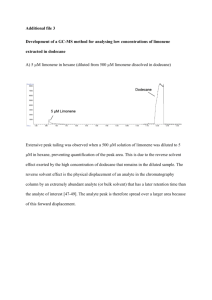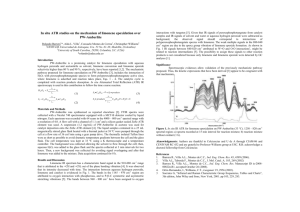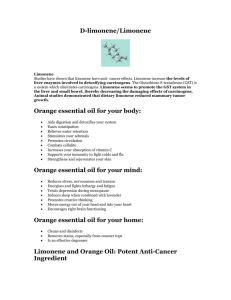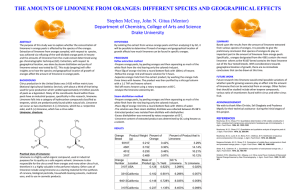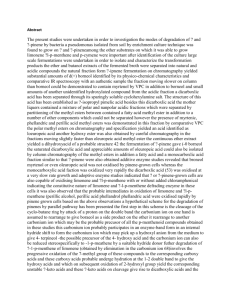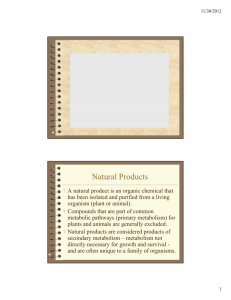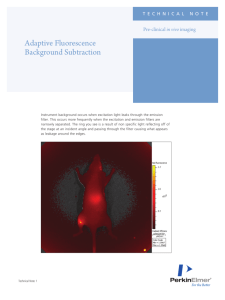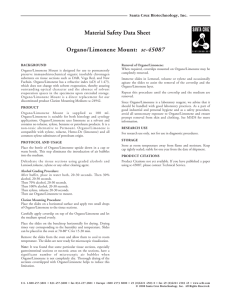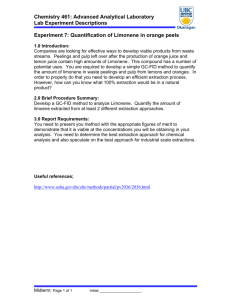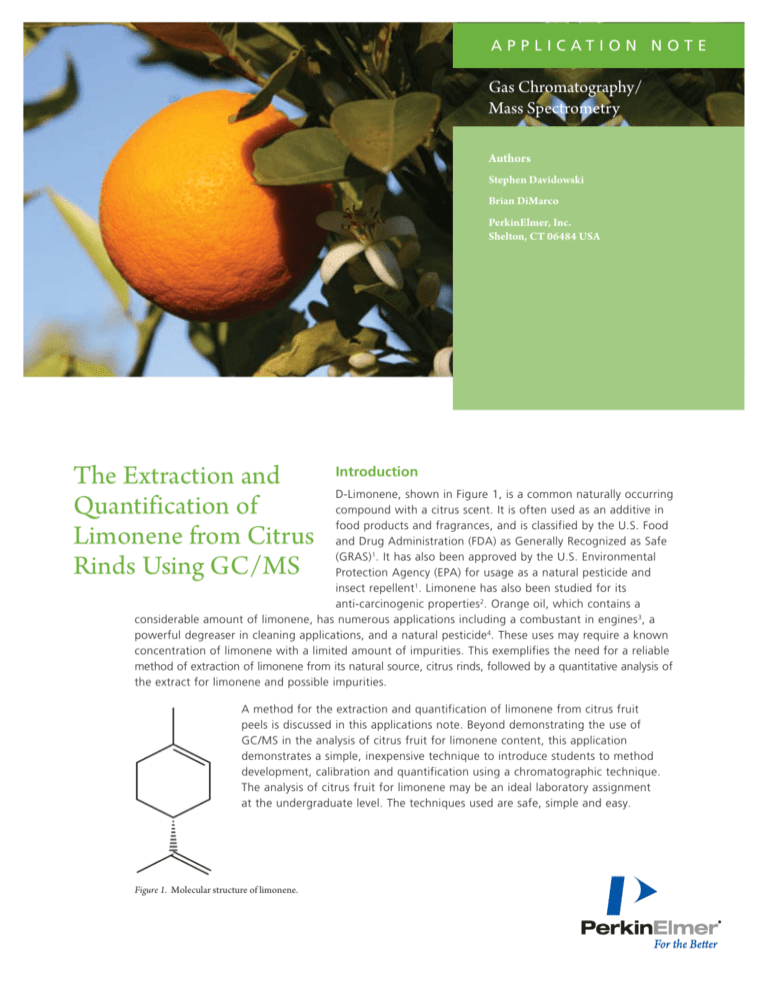
a p p l i c at i o n N o t e
Gas Chromatography/
Mass Spectrometry
Authors
Stephen Davidowski
Brian DiMarco
PerkinElmer, Inc.
Shelton, CT 06484 USA
The Extraction and
Quantification of
Limonene from Citrus
Rinds Using GC/MS
Introduction
D-Limonene, shown in Figure 1, is a common naturally occurring
compound with a citrus scent. It is often used as an additive in
food products and fragrances, and is classified by the U.S. Food
and Drug Administration (FDA) as Generally Recognized as Safe
(GRAS)1. It has also been approved by the U.S. Environmental
Protection Agency (EPA) for usage as a natural pesticide and
insect repellent1. Limonene has also been studied for its
anti-carcinogenic properties2. Orange oil, which contains a
considerable amount of limonene, has numerous applications including a combustant in engines3, a
powerful degreaser in cleaning applications, and a natural pesticide4. These uses may require a known
concentration of limonene with a limited amount of impurities. This exemplifies the need for a reliable
method of extraction of limonene from its natural source, citrus rinds, followed by a quantitative analysis of
the extract for limonene and possible impurities.
A method for the extraction and quantification of limonene from citrus fruit
peels is discussed in this applications note. Beyond demonstrating the use of
GC/MS in the analysis of citrus fruit for limonene content, this application
demonstrates a simple, inexpensive technique to introduce students to method
development, calibration and quantification using a chromatographic technique.
The analysis of citrus fruit for limonene may be an ideal laboratory assignment
at the undergraduate level. The techniques used are safe, simple and easy.
Figure 1. Molecular structure of limonene.
Experimental
External Calibration Curve
A limonene standard (SPEX CertiPrep®, Metuchen, NJ) with
a concentration of 1000 µg/mL was diluted to 100 µg/mL by
a 10:1 dilution with methanol. The remaining solutions were
prepared by serial 2:1 dilutions resulting in final limonene
concentrations of 50, 25, 12.5, and 6.25 µg/mL.
Extraction of limonene
Samples of lemon, orange, and grapefruit rinds were
carefully collected using a razor blade. The samples were
checked to ensure that none of the white flesh under the
rind was included in the sample, as shown in Figures 2 and 3.
The white flesh contributes to the mass of the sample but
contains little limonene; this makes the rinds appear to have
a lower limonene concentration. Then each sample was cut
down to a mass of approximately 0.1 g. The rind samples
were each placed in 7 mL vials with 5 mL of methanol. The
vials were shaken vigorously for 5 minutes and then allowed
to stand for an additional 5 minutes. After the 10-minute
extraction was complete, 0.5-mL aliquots of methanol from
each vial were diluted volumetrically (20:1 for lemon and
grapefruit rinds, and 10:1 for orange rind). These dilutions
were necessary in order to prepare solutions with concentrations of analyte within the range of the previously prepared
calibration curve.
Analysis and quantification of limonene
The analysis of the standards and samples was performed
with a PerkinElmer® Clarus® 560 D GC/MS, using the
parameters shown in Table 1. The GC was fitted with a
capillary injector port using a 4-mm standard glass liner
packed with quartz wool configured for split operation
(PerkinElmer Part No. N6121010). A PerkinElmer Elite™-5ms
(30 m x 0.25 mm x 0.25 µm) column (PerkinElmer Part No.
N9316282) was used throughout; the details of the method
are shown in Tables 1 and 2.
Figure 3. Example of a good sample of orange rind. (None of the white flesh is on
the sample).
Table 1. Operation Specifications for GC.
Gas Chromatograph: PerkinElmer Clarus 500 GC
Analytical Column:
Elite-5ms (30 m x 0.25 mm x 0.25 μm)
Injector-Port Type:
Capillary
Injector-Port Temp:
250 ˚C
Injection Type:
Split (20 mL/min)
Syringe Volume:
5 μL
Injection Volume:
0.5 μL
Injection Speed:
Fast
Rinse Solvent:
Methanol
Carrier-Gas Program:
1 mL/min
Oven Program:
Temperature Hold Time Rate
80 ˚C
3 min
5 ˚C/min
140 ˚C
0 min
45 ˚C/min
275 ˚C
Hold
Table 2. Operation Specifications for MS.
Figure 2. Example of an orange rind being cut with a razor blade.
2
Mass Spectrometer:
PerkinElmer Clarus 560 D MS
GC Inlet Temp:
250 ˚C
Ion-Source Temp:
250 ˚C
Function Type:
Full Scan
Full-Scan Range:
m/z 40-300
Full-Scan Time:
0.15 sec
Interscan Delay:
0.05 sec
Solvent Delay:
2.5 min
Discussion
Mass spectra for the limonene standard and limonene in the
extract are shown in Figure 4. The limonene spectrum and
retention time in the standard matched those of the fruit
extract, and a NIST library search also supported the identification as limonene. The chromatogram for m/z 136 was
chosen for quantification because it is a unique, high m/z
peak that is relatively abundant; higher m/z peaks generally
experience a better signal-to-noise ratio.
Figure 6. Calibration curve of limonene used to quantify the samples.
Table 3. Intermediate and Final Results for the Analysis of
Lemon, Grapefruit and Orange Rinds.
Diluted
Conc. (µg/mL) Undiluted
Conc. (µg/mL) Mass
Extracted
(µg) Mass of
Sample
(g)
%
wt/wt
35.66
713.2
3566
0.1199
2.97
Grapefruit 44.55
891.0
4455
0.1557
2.86
Orange 356.2
1781
0.1096
1.63
Lemon
Figure 4. Mass spectrum for limonene in the rind extract (top) and in the standard
(bottom).
The extracted m/z 136 ion chromatogram for the orange
sample is shown in Figure 5. The amount of limonene in
each sample was quantified by plotting a calibration curve
using the instrument response at m/z 136, shown in Figure 6.
The linear regression analysis of the calibration curve in
Figure 6 yielded Equation 1, which was used to calculate
the concentration of limonene in the sample. These concentrations were then used to calculate the concentrations of
the undiluted solutions, which were then used to determine
the wt/wt % of limonene in each fruit’s rind; these results
are shown in Table 3.
Equation 1:
y = 941.4172x + 2317.1604
35.62
Conclusion
This application note demonstrates a simple extraction and
quantification method for limonene using GC/MS. The
limonene extraction and calibration curve preparation were
discussed, as well as the method for analysis. The results
obtained by following this method were presented along
with the final %wt/wt of oil in the rinds. It was discovered
that while all of these fruits had limonene in their rinds,
lemon contained the highest concentration. Students conducting this analysis will gain valuable experience in sample
preparation, solid-liquid extractions, and one of the most
sensitive analytical techniques for the analysis of volatile
compounds.
Figure 5. The extracted ion chromatogram for the 100 μg/mL limonene standard
(top) and the diluted orange extract (bottom) at m/z 136.
3
References
1.Limonene. R.E.D. Facts. 1994. USA EPA: http://www.epa.
gov/oppsrrd1/REDs/factsheets/3083fact.pdf
2.Crowell PL, Gould MN. “Chemoprevention and therapy of
cancer by d-limonene.” 1994 Crit Rev Oncog.; 5(1):1-22
3.Cyclone Power Technologies Inc. Why It’s Better 2009.
http://www.cyclonepower.com/better.html
4.Orange Oil: http://en.wikipedia.org/wiki/Orange_oil
PerkinElmer, Inc.
940 Winter Street
Waltham, MA 02451 USA
P: (800) 762-4000 or
(+1) 203-925-4602
www.perkinelmer.com
For a complete listing of our global offices, visit www.perkinelmer.com/ContactUs
Copyright ©2009, PerkinElmer, Inc. All rights reserved. PerkinElmer® is a registered trademark of PerkinElmer, Inc. All other trademarks are the property of their respective owners.
008856_01

